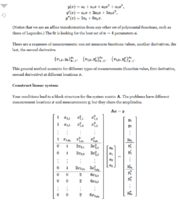Yes. A linear function, y= ax+ b, has two coefficients, a and b, that need to be determined so you need to equations. One way to do that is to use two different points- a line is determined by two points- so you have
y0=ax0+b and
y1=ax1+b to solve for a and b. But knowing the value and slope (derivative) at a single point also gives two equations:
y0=ax0+b and
a=a0 gives
y0=a0x0+b so
b=y0−a0x0. The equation of the linear function with value
y0 and slope
a0 at
x=x0 is
y=a0x+y0−a0x0.
Similarly, a quadratic,
y=ax2+bx+c has three coefficients so we need three equations. We can get three equations using three points- a parabola is determined by three points- or using the value, first derivative, and second derivative at one point. For example, if
y(x0)=y0,
y′(x0)=m0, and
y′′(x0)=m1 then
y(x0)=ax02+bx0+c=y0
y′(x0)=2ax0+b=m0 and
y′′(x0)=2a=m1.
Three equations we can solve for a, b, and c.
Finally, a cubic,
y=ax3+bx2+cx+d has four coefficients so we need four equations. We can get those equations by using four points- a cubic is determined by four points- or using the value, first derivative, second derivative, and third derivative at one point. For example, if
y(x0)=y0,
y′(x0)=m0,
y′′(x0)=m1, and
y′′′(x0)=m2 then we have
y(x0)=ax03+bx02+cx0+d=y0
y′(x0)=3ax02+2bx0+c=m0
y′′(x0)=6ax0+2b=m1 and
y′′′(x0)=6a=m2.
Four equations we can solve for a, b, c, and d.
Of course, that can be extended to polynomials of any degree, n. Such a polynomial has n+ 1 coefficients so we need n+ 1 equations. Those can be the value of the polynomial at n+ 1 different points or the value of the polynomial and its first n derivatives at a single point.



